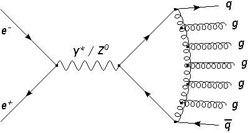World Record for One-Loop Calculations

This Feynman diagram illustrates the collision between an electron and positron (left), with their annihilation and the formation of a quark, an anti-quark, and five gluons (right).<br>Ill.: THEP, Mainz<br>
Scientists at Johannes Gutenberg University Mainz (JGU) have set a new record for the calculation of scattering amplitudes. This kind of calculation is used to predict the outcome of accelerator experiments in which high-energy particles collide with one another.
However, the calculations become increasingly difficult the greater the number of orders the physicists wish to calculate. Professor Dr. Stefan Weinzierl's work group has now developed an algorithm which is far faster and requires less computing capacity than other algorithms. “We have made a huge leap forward and applied a completely new method allowing us to calculate far more than before,” explains Weinzierl. He assumes that the new calculation method can be applied to both completed experiments in the Large Electron-Positron Collider (LEP), which was in operation at Geneva's CERN research center until the year 2000, as well as new experiments in the Large Hadron Collider (LHC).
The new algorithm allows, for instance, for the calculation of physical observables related to the collision of an electron with its antiparticle, the positron, during which a quark, an anti-quark, and gluons are created. For the first time ever, it has been possible to do a calculation with one loop and eight external particles – a new world record in theoretical high-energy physics.
Precision calculations in particle physics make use of the perturbation theory and the results can be displayed in what are called loop diagrams. The higher the number of external particles, the more difficult is the calculation. The algorithm now being used is a new and efficient method based on subtraction and numerical integration. The calculations are performed using a PC cluster system located at the Center of Data Processing at Mainz University. According to Weinzierl, the new method is not only applicable to electron-positron annihilation, but with slight modifications can also be used to calculate hadron-hadron collisions of the kind that occur in the LHC in Geneva. The theoretical physicists at Mainz University intend to investigate this aspect further in the near future.
Professor Dr. Stefan Weinzierl's work is part of the JGU Excellence Cluster Precision Physics, Fundamental Interactions and Structure of Matter (PRISMA). The cluster has made it into the final selection round of Germany's Federal Excellence Initiative and has submitted a proposal for continued financing in the second round.
Media Contact
More Information:
http://www.uni-mainz.de/eng/14739.phpAll latest news from the category: Physics and Astronomy
This area deals with the fundamental laws and building blocks of nature and how they interact, the properties and the behavior of matter, and research into space and time and their structures.
innovations-report provides in-depth reports and articles on subjects such as astrophysics, laser technologies, nuclear, quantum, particle and solid-state physics, nanotechnologies, planetary research and findings (Mars, Venus) and developments related to the Hubble Telescope.
Newest articles

Superradiant atoms could push the boundaries of how precisely time can be measured
Superradiant atoms can help us measure time more precisely than ever. In a new study, researchers from the University of Copenhagen present a new method for measuring the time interval,…

Ion thermoelectric conversion devices for near room temperature
The electrode sheet of the thermoelectric device consists of ionic hydrogel, which is sandwiched between the electrodes to form, and the Prussian blue on the electrode undergoes a redox reaction…

Zap Energy achieves 37-million-degree temperatures in a compact device
New publication reports record electron temperatures for a small-scale, sheared-flow-stabilized Z-pinch fusion device. In the nine decades since humans first produced fusion reactions, only a few fusion technologies have demonstrated…





















